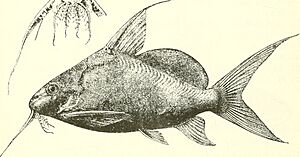Synodontis resupinatus facts for kids
Synodontis resupinatus is a special kind of catfish often called an "upside-down catfish." This fish lives in the Niger and Bénoué River basins. You can find it in countries like Cameroon, Mali, and Nigeria. A scientist named George Albert Boulenger first described this fish in 1904. He found specimens near a place called Lokoja in Nigeria.
Quick facts for kids Synodontis resupinatus |
|
|---|---|
 |
|
| Conservation status | |
| Scientific classification | |
| Genus: |
Synodontis
|
| Species: |
resupinatus
|
Contents
What Does This Fish Look Like?
Like other Synodontis fish, S. resupinatus has a strong, bony head. This head bone goes all the way back to its first fin spine. It also has a unique bony bump on its head called a humeral process. This bump helps scientists tell different Synodontis species apart. For S. resupinatus, this bump is flat, rough, and longer than it is wide. It has a blunt, pointed end.
Its Whiskers (Barbels)
This fish has three pairs of barbels, which are like whiskers. One pair is on its upper jaw, and two pairs are on its lower jaw. The upper whiskers are straight and have a wide base. They are a bit longer than the fish's head. The outer lower whiskers are about half the length of its head. The inner lower whiskers are about one-third the length of its head. These lower whiskers have long, thin branches, and even smaller branches coming off them.
Its Fins
The front edges of the dorsal fin (on its back) and the pectoral fins (on its sides) are stiff spines. In S. resupinatus, the dorsal spine is as long as its head. It is slightly curved and smooth on both sides. The rest of the dorsal fin has seven soft rays and a very long, thin tip.
The pectoral fin spine is as long as the dorsal spine. It has jagged edges on both sides. The adipose fin, a small fleshy fin near the tail, is two and a half times longer than it is deep. The anal fin, on its underside, has five unbranched and eight branched rays. It has a pointed shape. The tail, or caudal fin, has a deep notch. The upper part of the tail tapers into a fine point.
Its Teeth
All Synodontis fish have a special pad of teeth on the very front of their upper jaw. This is called a premaxillary toothpad. It has several rows of short, chisel-shaped teeth. In S. resupinatus, this toothpad forms a short, wide band.
On its lower jaw, the teeth are attached to flexible, stalk-like structures. They are described as "s-shaped" or "hooked." The number of teeth on the lower jaw helps identify different species. S. resupinatus has about 60 teeth on its lower jaw.
Its Color and Size
The fish is a pale grayish-brown on its back and sides. Its underside is black. The fins are gray, and its whiskers are whitish. The largest S. resupinatus ever measured was about 26 centimetres (10 in) long. Female Synodontis fish are usually a bit larger than males of the same age.
Habitat and Reproduction
In the wild, Synodontis resupinatus lives in the Niger and Benue River basins. People catch this fish for food. It lives in streams and lakes. It eats tiny water organisms called plankton, plants, and dead organic matter.
Reproduction and Life Cycle
Scientists do not know much about how most Synodontis species reproduce. They have found eggs in some female fish, which tells them a little. Spawning, or laying eggs, likely happens during the flooding season. This is usually between July and October. During spawning, pairs of fish swim together. The fish grow quickly in their first year. After that, their growth slows down as they get older.


